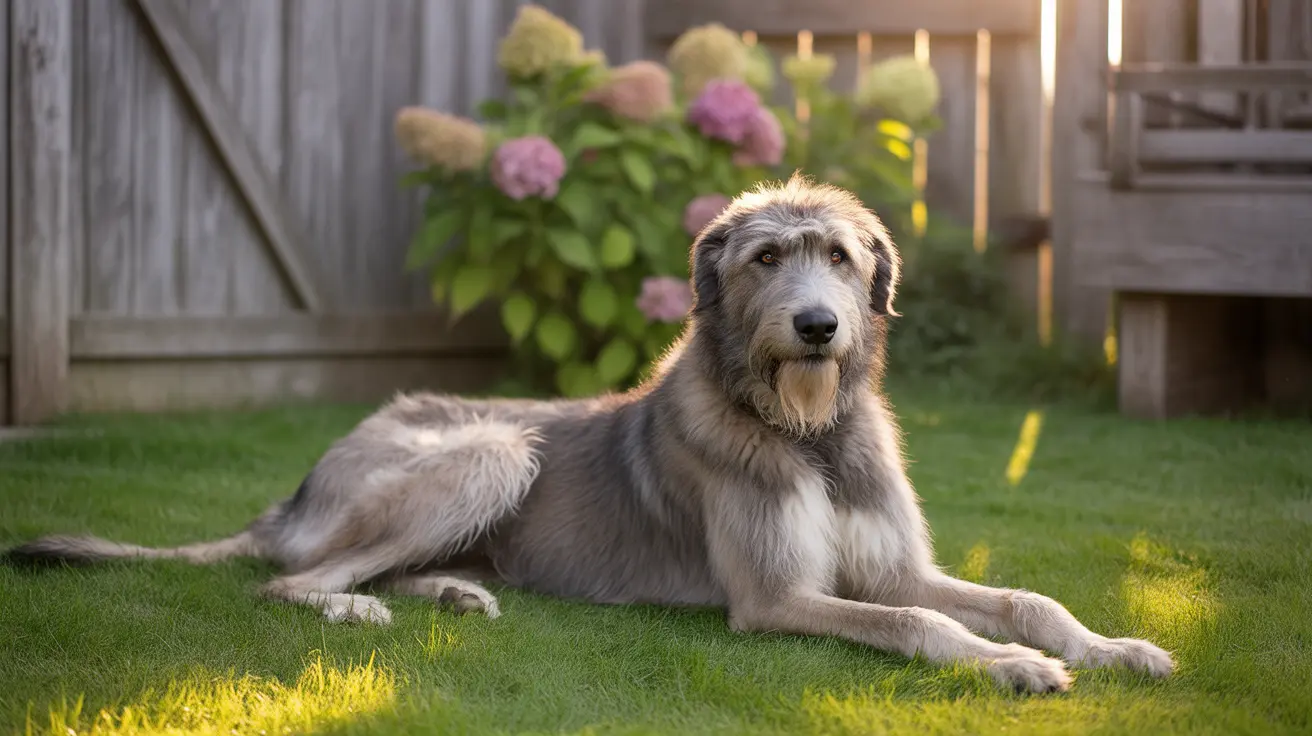Giant dog breeds have a unique way of capturing our hearts with their impressive size and gentle dispositions. These magnificent creatures, ranging from the towering Irish Wolfhound to the muscular English Mastiff, bring extraordinary joy and companionship to those ready to embrace the challenges of big dog ownership.
While their sheer presence can be awe-inspiring, owning a giant breed dog comes with significant responsibilities that potential owners must carefully consider. From specialized healthcare needs to specific space requirements, these gentle giants demand a level of commitment that goes beyond what's typically required for smaller breeds.
This comprehensive guide explores everything you need to know about giant dog breeds, from their unique care requirements to specific breed characteristics, helping you make an informed decision about welcoming one of these magnificent animals into your home.
Understanding the Basics of Giant Breed Dogs
Giant dog breeds typically reach their full size between 18 and 24 months, with most of their growth taking place during their first year. Their growth period is marked by rapid increases in weight and height, which can have a direct impact on their skeletal health and overall development. Proper management during puppyhood is essential to ensure these dogs develop strong joints and bones and to prevent future health complications.
Giant breed dogs are defined by their substantial size and weight. Most fall within the range of 100 to 230 pounds or even more. Their grand scale not only adds to their visual appeal but also greatly shapes their care requirements, from the type of food they eat to the space they need to live comfortably.
Space Requirements and Living Conditions
Large dog space needs are significant and non-negotiable. These breeds require ample room to move, stretch, and exercise comfortably. A spacious home with access to a secure outdoor area is ideal for these magnificent animals to thrive and maintain their physical and mental well-being. Small apartments may not provide enough room for these dogs, and lack of space can lead to behavioral issues or health problems related to inactivity. If you are considering a giant breed, make sure you have an environment that can accommodate their substantial size, including wide doorways, roomy living spaces, and durable furniture.
Health Considerations for Giant Breeds
Big dog health concerns require special attention and proactive care. Due to their large size, these dogs are susceptible to certain conditions more frequently than smaller breeds. Common issues include:
- Hip and elbow dysplasia: Developmental issues affecting the joints that can lead to pain and mobility problems.
- Heart conditions, particularly dilated cardiomyopathy: Some giant breeds have a genetic predisposition to heart disease.
- Gastric dilatation-volvulus (bloat): A life-threatening emergency where the stomach twists, requiring immediate veterinary intervention.
- Joint problems: Stress on bones and joints increases the risk of arthritis and mobility issues as the dog ages.
- Shorter large dog lifespan (typically 7-10 years): Their bodies age more quickly, making regular veterinary care and monitoring vital.
Regular check-ups, early detection, and preventative care play a crucial role in ensuring your giant breed remains as healthy as possible for as long as possible.
The Financial Aspect of Giant Dog Care
The cost of giant dogs extends well beyond the initial purchase price. Due to their size, virtually every expense is magnified compared to smaller breeds. Owners should be prepared for:
- Higher food costs: These dogs eat much larger portions, and their diets often require high-quality ingredients.
- Increased veterinary expenses: Preventive care, routine check-ups, and medications often scale with weight.
- Specialized equipment and supplies: Extra-large beds, leashes, collars, and crates designed for giant dogs are typically more expensive and less commonly available.
- Regular grooming expenses: Many giant breeds have thick or long coats that require professional grooming sessions.
- Potential medical emergencies: The risk and cost of treatment for conditions like bloat or orthopedic surgery can be significant.
Planning for ongoing costs ensures you’re financially ready for the commitment of a giant breed dog, helping you avoid surprises and provide excellent care throughout their lives.
Training and Socialization: Critical Components
Early dog training is essential for giant breeds. Given their size and potential for immense strength, proper training isn’t just helpful—it’s mandatory. Uncontrolled giant breeds can unintentionally cause injuries or become difficult to manage in public or at home. Key aspects include:
- Basic obedience training from puppyhood: Teaching commands like sit, stay, come, and heel is crucial for maintaining control.
- Consistent socialization with people and other animals: Regular exposure from an early age helps giant breeds develop into confident, friendly adults and prevents fear or aggression.
- Leash training and impulse control: Due to their immense pulling power, proper leash manners are necessary to ensure safe and comfortable walks.
- Positive reinforcement techniques: Using rewards and encouragement helps giant dogs learn quickly without resorting to force or harsh correction.
Investing time and effort in these areas not only creates a safer environment but also forms a deep bond between you and your dog.
Nutrition and Exercise Requirements
Feeding big dogs requires careful attention to their nutritional needs. Their diets must support both growth and joint health, while preventing excessive weight gain. A balanced diet should include:
- High-quality protein sources: Essential for muscle development and maintenance.
- Joint-supporting nutrients: Ingredients such as glucosamine and chondroitin can help protect long-term joint health.
- Controlled portions to prevent rapid growth: Steady weight gain is healthier and reduces the risk of skeletal problems.
- Appropriate caloric intake for their age and activity level: Puppies, active adults, and seniors have different energy needs.
Exercise Considerations
Large dog exercise needs careful planning to protect their developing and aging joints while maintaining fitness. Over-exercising young, growing giant breeds can cause joint damage, so moderate activity is recommended until growth plates have closed. Recommended activities include:
- Daily structured walks: Regular, controlled exercise is crucial for both mental stimulation and maintaining a healthy weight.
- Supervised play sessions: Engaging in interactive play strengthens the owner-dog bond and helps to burn off excess energy.
- Swimming (for water-loving breeds): An excellent low-impact activity that helps build muscle without straining joints.
- Mental stimulation exercises: Puzzle toys, obedience games, and scent work keep these intelligent breeds engaged and happy.
Finding a balance between exercise and rest is key to supporting your giant dog’s health throughout each life stage.
Popular Giant Breed Profiles
Irish Wolfhound
The tallest of all dog breeds, Irish Wolfhounds are celebrated for their dignified appearance, calm demeanor, and ancient hunting heritage. Despite their size, they are known for being gentle, affectionate, and excellent family companions when appropriately socialized.
Great Dane
Elegant and noble, Great Danes are often referred to as "gentle giants." They combine grace with impressive size and are loyal, friendly, and love human interaction. Their patience makes them excellent pets for families willing to accommodate their stature.
Saint Bernard
Famous rescue dogs from the Swiss Alps, Saint Bernards are powerful yet incredibly patient and loving. Their nurturing personalities and impressive strength have endeared them to dog lovers worldwide. They require space, gentle handling, and regular grooming due to their thick coats.
Newfoundland Dog
Newfoundlands are exceptional water dogs with nurturing dispositions and remarkable swimming abilities. They are often called "nanny dogs" due to their patience with children and gentle, protective nature. Their thick waterproof coat requires consistent grooming to prevent matting.
Tibetan Mastiff
Revered as ancient guardian breeds, Tibetan Mastiffs are watchful, independent, and devoted to their families. They have strong protective instincts and a luxurious, dense coat. Early socialization is vital to temper their natural aloofness with strangers.
Frequently Asked Questions
- What are some popular giant dog breeds? Popular breeds include the Irish Wolfhound, Great Dane, English Mastiff, Saint Bernard, and Tibetan Mastiff.
- How much space do big dogs need? Large breeds need ample indoor and outdoor space to move comfortably. Homes with secure yards or access to parks are ideal.
- Are giant dog breeds good with children? Many giant breeds are gentle with children if properly socialized early. Supervision is always recommended, especially due to their size.
- What are common health problems in big dogs? They often face joint issues, heart conditions, and bloat.
- How long do large dog breeds live? Most giant breeds have a shorter lifespan, generally between 7 and 10 years.
- Is caring for a big dog expensive? Yes, costs are higher due to food, medical care, grooming, and space requirements.
- How important is early training for giant breeds? Early, consistent training is crucial for managing their size and strength, helping to ensure safe and happy interactions.
- What diet is recommended for big dogs? A balanced diet with joint support nutrients and controlled calories is essential to maintain health and prevent obesity.
- Do big dogs need more exercise than small breeds? They require daily exercise but should avoid excessive running or high-impact activities to protect their joints.
- Can large breeds adapt to apartment living? It's challenging but possible with a strong commitment to exercise, space management, and enrichment activities.
- Why is socialization important for large dogs? Socialization helps prevent fear-based reactions or aggression, ensuring your dog is well-adjusted and safe to be around people and other animals.
While giant dog breeds require significant commitment in terms of time, space, and resources, they offer unparalleled companionship and loyalty. Their gentle nature, combined with proper training and care, makes them extraordinary family members for those prepared to meet their unique needs. Understanding these requirements before bringing home a giant breed ensures a harmonious relationship that will enrich both human and canine lives.






